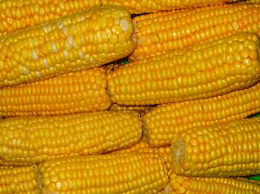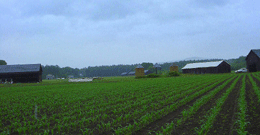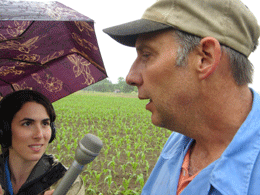GE Corn Causes Concern
Air Date: Week of July 17, 2009

The agricultural giant, Syngenta, has petitioned the U.S. Department of Agriculture to grant its new genetically modified corn a non-regulated status. This means that the company’s new seeds could be grown without management or geographic restrictions across the country. Some food experts, and farmers, fear that if this corn is grown without limits, it could end up in the food supply. Living on Earth’s Jessica Ilyse Smith reports.
Transcript
YOUNG: From the Jennifer and Ted Stanley Studios in Somerville, Massachusetts, this is Living on Earth. I’m Jeff Young.
Nearly a quarter of the corn planted in the United States does not go to groceries or feedlots—it goes in our gas tanks as ethanol. Now agriculture giant Syngenta has genetically engineered a new strain of corn to be grown specifically for ethanol--not for human consumption.
The US Department of Agriculture is about to decide how it should be regulated.
And Living on Earth’s Jessica Ilyse Smith reports concerns are cropping up about this genetically modified corn ending up in our food.
[SOUND OF RAIN]
SMITH: Heavy rains fall from dark grey clouds onto the seemingly endless rows of corn on Czajkowski Farm in Hadley, Massachusetts. Joe Czajkowski walks through the rows checking on his crops.
CZAJKOWSKI: They say, rain makes grain, and I think we’re in the right place for that today.
SMITH: Czajkowski grew up among these cornfields, watching his grandfather who started this farm in 1914.

Czajkowski Farm in Hadley, Massachusetts. (Photo: Jessica Ilyse Smith)
SMITH: The corn grown on Czajkowski’s 300-acre farm is mostly for human consumption. But, twenty four million acres of US grown corn goes to ethanol production. Now, Syngenta wants to introduce a genetically modified strain of corn for ethanol into this mix. That concerns Czajkowski.
CZAJKOWSKI: I think we really have to have a better understanding of what this all means and what effects it will have.
[SOUND OF WALKING IN RAIN]
SMITH: Czajkowski sloshes to a nearby barn to get out of the rain. He’s worried that pollen from genetically engineered corn could drift into his crops.
CZAJKOWSKI: Most of the pollen from corn falls within 20 to 50 feet of where the tassel releases the pollen. Pollen stays pretty close to home, but with the right conditions it can travel a little ways; it doesn’t move that far, but it does travel.
SMITH: Most scientists agree that pollen can drift. Ruth Hazzard coordinates the University of Massachusetts Extension vegetable program.
HAZZARD: It’s usually viable about 24 hours, but with higher humidity and cooler temperatures it could remain viable longer, with prevailing winds, it could move farther.
SMITH: Hazzard cites a University of Maine study that looked at the potential for pollen to drift from a genetically modified cornfield to a field of conventional corn. Researchers looked at two fields 30 and 100 meters from the genetically modified cornfield. By the end of the two-year study, genetically modified plants, were growing in both fields.
HAZZARD: If you are talking expanding this into millions of acres where you have food crops and industrial crops next to each other, I think that it would be virtually impossible to avoid contamination of the food crops.
SMITH: Syngenta declined to comment for this story, but some industry scientists say that this newly engineered corn has environmental benefits that outweigh the concern of drifting pollen. Dr. Michael Wach is a managing director of science and regulatory affairs at the Biotechnology Industry Organization. He says that Syngenta’s new corn, which is scientifically referred to as Event 3272, is modified to tolerate heat—so less energy will be needed to produce ethanol.

About a quarter of all corn acreage in the United States is for ethanol.
SMITH: Wach says this enzyme makes producing ethanol more efficient because it cuts out the need to cool large amounts of water in the production process.
WACH: And we’re talking about large volumes of liquid here when we make ethanol from starch, and therefore if you don’t have to do that it save a lot of electricity. And that converts to saving money and that converts to making the ethanol a more carbon-neutral product.
SMITH: Syngenta has petitioned the U.S. Department of Agriculture to grant this corn non-regulated status. Michael Gregoire, the deputy administrator of the USDA’s Biotechnology Regulatory Services, says this status will make distribution of their corn easier.
GREGOIRE: Basically what non-regulated status means is that they are no longer subject to our regulatory restrictions or oversight so they can be moved in or stored or planted without any permit from the agency.
SMITH: If Syngenta can show the new corn won’t cause disease or injury to other plants—pose what’s called a plant pest risk—Gregoire says it will win non-regulated status.
And if the USDA gives Syngenta the green light, farmers will be able to grow this corn without restriction, making it the first non-regulated, genetically modified crop grown in the U.S. solely for industrial purposes.
This worries Dr. Jane Rissler at the Union of Concerned Scientists. She’s deputy director of the organization’s Food and Environment Program. Rissler says that if Syngenta’s corn is commercialized it is inevitable that food corn will be contaminated…and this could lead to health problems.
RISSLER: We’re concerned about the allergenicity of this enzyme—that is, will some people have an allergic reaction to this enzyme. It has never been in the food supply before, so we have no idea what the reaction of the general population or a subset of that would be.
SMITH: Rissler points out that food processors are also worried about the quality of their products if the new corn gets into the food supply. The enzymes in Syngenta’s genetically engineered corn survive at very high temperatures so they do not breakdown during baking and other food processing. So, there could be consequences…
RISSLER: For example, cornstarch that is used to thicken pies that you buy in the grocery store—this enzyme would have survived the baking process and could break down the cornstarch, which is used to thicken the pie, could break it down to sugar. That means that when you bought the pie it would be watery not thickened.
SMITH: But Rissler’s biggest concern is that non-regulated status for Syngenta’s corn could set a bad precedent. She says that the USDA’s recent public notice included a new take on what should be considered a plant pest. With this new interpretation, she says, most genetically engineered crops are no longer considered plant pests.
RISSLER: And this is a startling change from the past 22 years of regulation. A company developing a genetically engineered crop could go to the USDA and say, “according to your new interpretation this crop is not a plant pest. And therefore is not subject to USDA oversight.”
SMITH: This change could have a profound effect on U.S. agriculture.
[SOUND OF RAIN]
SMITH: Back in the soggy cornfield, farmer Joe Czajkowski hasn’t yet made up his mind about genetically modified corn, but wants more public discussion.

Reporter Jessica Ilyse Smith talks with Joe Czajkowski.
SMITH: The USDA has just wrapped up the public comment period on the proposed regulation of Syngenta’s new corn. And all ears await the fate of Event 3272.
For Living on Earth, I’m Jessica Ilyse Smith in Hadley, Massachusetts.
Links
Read Syngenta’s Petition to the USDA in the Federal Register.
Read the Union of Concerned Scientists’ comments to the Federal Register.
Living on Earth wants to hear from you!
Living on Earth
62 Calef Highway, Suite 212
Lee, NH 03861
Telephone: 617-287-4121
E-mail: comments@loe.org
Newsletter [Click here]
Donate to Living on Earth!
Living on Earth is an independent media program and relies entirely on contributions from listeners and institutions supporting public service. Please donate now to preserve an independent environmental voice.
NewsletterLiving on Earth offers a weekly delivery of the show's rundown to your mailbox. Sign up for our newsletter today!
 Sailors For The Sea: Be the change you want to sea.
Sailors For The Sea: Be the change you want to sea.
 The Grantham Foundation for the Protection of the Environment: Committed to protecting and improving the health of the global environment.
The Grantham Foundation for the Protection of the Environment: Committed to protecting and improving the health of the global environment.
 Contribute to Living on Earth and receive, as our gift to you, an archival print of one of Mark Seth Lender's extraordinary wildlife photographs. Follow the link to see Mark's current collection of photographs.
Contribute to Living on Earth and receive, as our gift to you, an archival print of one of Mark Seth Lender's extraordinary wildlife photographs. Follow the link to see Mark's current collection of photographs.
 Buy a signed copy of Mark Seth Lender's book Smeagull the Seagull & support Living on Earth
Buy a signed copy of Mark Seth Lender's book Smeagull the Seagull & support Living on Earth

